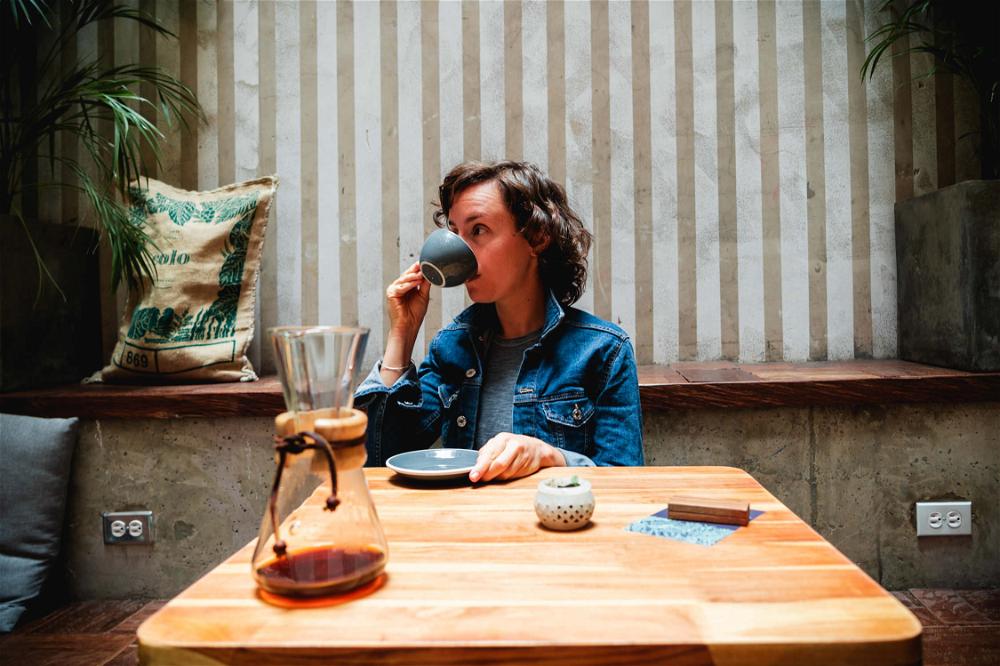12 Ways to Help You Take Better Photos in Cafes

Cafe photography is challenging. To discover how to take photos in cafes and coffee shops, try these tips for how to deal with harsh light, dark interiors and color correction.
This article may contain affiliate links. We earn a small commission when you purchase via those links — at no extra cost to you. It's only us (Becca & Dan) working on this website, so we value your support! Read our privacy policy and learn more about us.
Table of contents
- Get to the cafe early
- Make appointments and explain your goals
- Get creative during your shoot, try different compositions
- When shooting food and drink, try and be fast
- Find a safe place to put your photography backpack
- Don’t be afraid to talk to people
- Color correcting dark interiors and dealing with low light
- How to shoot food outside with harsh light
- How to make coffee look interesting
- Use the cafe to tell a story
- Be mindful of the other cafe customers
- Leverage specialty design elements in cafes
Taking photos in coffee shops and cafes are one of the ways I learned about my love for photography, and also for coffee.
Through flat lays, close-ups, photos of steam coming off a mug and coffee cups with great backgrounds, photos in cafes has been a way for me to remember where I traveled and where I enjoyed time.
From lighting to background to your technique and your equipment, check out the best ways to take photos in cafes, below.
Get to the cafe early
In Mexico City, cafes typically open around 8 or 9 am, which was the first lesson to learn. After a shoot or two, I learned that we should be asking cafes if we can come right when they open for the day, in order to minimize distractions and have a chance at having empty tables. If you’re shooting outdoor cafe photos, check our sunrise and sunset calculator to plan for the best natural lighting conditions.
In other parts of the world, you may find that cafes open at wildly different times, from the norms of opening at 10 am for cafes in Taipei, to 7 am for cafes in Brooklyn, NY.
This also gave me a chance to take photos of baristas during their coffee-crafting process, without being in the way of other paying customers.
This can make the cafe look empty. Depending on the look you’re going for, you might want to reconsider if you’d rather the cafe look full of patrons.



Make appointments and explain your goals
Together, Becca and I contacted the cafes and laid out our reasons for wanting to come and shoot. We explained that we wanted to learn about each cafe and its specialty, while also having a chance to talk to some staff about specific features.
We also aimed to wind up with an archive of amazing coffee shop photos that we could use for purposes in years to come across all our content.
Our messaging mentioned wanting to take photos for use on our blog. We told each cafe that they’d also be welcome to use our photos online and in social media, with credit to us. By making appointments, we avoided showing up ‘un-announced.’

Get creative during your shoot, try different compositions
One of our favorite cafes to shoot at is Blend Station.
This is because, in addition to having a big open space, the cafe has its own design theme and branding. By asking to use some of their available marketing material like postcards, I stacked coffees with these cards to make unique compositions that stood out as being ‘more than a cup of coffee.’
Consider bringing some of your own props, such as a laptop, book or pair of glasses, to complete a theme of ‘laptop-friendly cafes’ or ‘cafes good for reading.’
Go for a flat lay
Becca’s favorite way to shoot coffees has always been the flat lay style.
This means she sets up a “scene” on the table that tells a story of where we are, whether it’s Portugal, Israel or Upstate New York.
With flat lays, the idea is to have the camera hovering above the table in parallel to the table surface. Usually about 12 inches above the table does the job. The coffee cups should appear as circles, and so should plates or saucers. There should not be any skewing of planes.
The way to make flat lays look interesting is to add a human element, as we’ll detail below, and to add fun or unique context items like a travel guidebook, sunglasses, some bills or coins, a camera or a pastry.


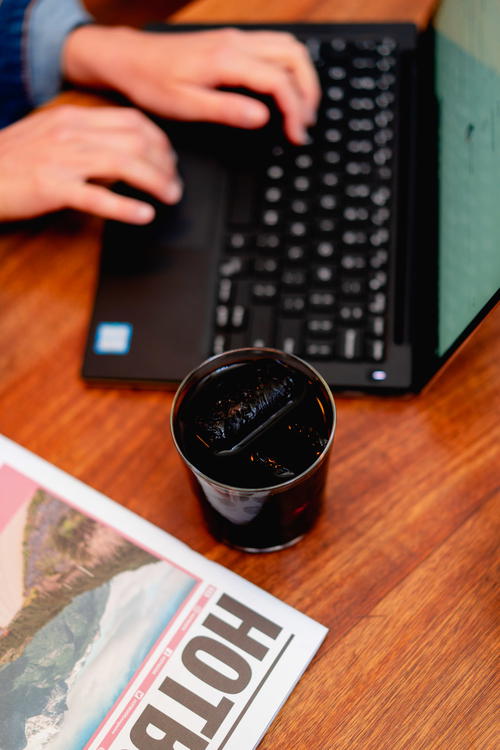
When shooting food and drink, try and be fast
Shooting coffees, lattes and smoothies taught me to work fast, or the product would start to look less fresh.
With latte art, I shot immediately, also knowing that if I took a sip, the art would be ruined. Latte art also tends to shift and dilute, the longer you wait after it has been poured.
With smoothies, they melt fast! I had to shoot smoothies as soon as they were put down on the table, or else they’d melt into mush.
Shooting black coffee is much easier, but if you shoot iced coffee, consider that the ice may start melting and it won’t look the same. In fact, iced coffee can start to look somewhat like dark tea, if the ice cubes melt and you’re left with a murky cup of brown liquid.
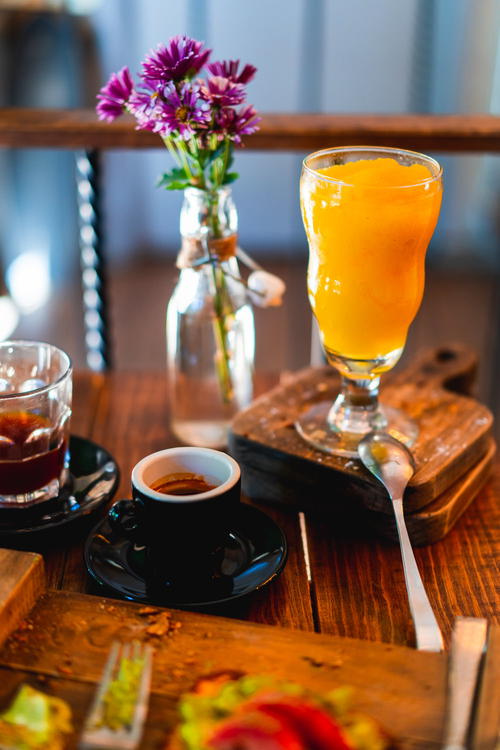


Find a safe place to put your photography backpack
Whenever I’m in a cafe, I come with a camera and perhaps another lens or two. If I’m traveling and happen to have a larger-size photography backpack, I have to find a place to set it down in case the cafe is tight on space.
In these instances, speak to a barista or the owner of the coffeeshop. Ask if there’s a safe place where you can set down your bag (which likely contains a high value of gear). If not, leave it in a spot where there will be multiple eyes on it for the duration of the time you assume you’ll be there. As another idea, grab a table, or come with a buddy who can watch your things while you take a few photos.
For the reasons here, I like to travel with a photography backpack that doubles as a daypack or laptop bag. A good one is the new photography bag from Moment. I recommend checking out my Moment Everything Backpack review to get a glimpse into what a backpack like this could look like for your next photo outing.


Don’t be afraid to talk to people
By sitting down with several of the owners of some of Mexico City’s most famed specialty cafes, I was able to understand more about each venue, and therefore shift focus toward what was important.
I spoke with one of the owners of Almanegra Cafe, who told us the story of the Pagan design elements and minimalism behind the cafe’s design and vibe.
This helped me shoot photos in line with the vision. After the photos were done and our review was published, the owners were delighted with my work and re-published it on various media outlets.
Color correcting dark interiors and dealing with low light
Low light inside cafes was one of my biggest struggles in this cafe project. Every cafe has different lighting situations and variable access to available natural light.
Some cafes have huge skylights, and others have a small amount of track lighting. This is totally fair, as not every cafe is going to have studio-quality light for me to shoot their coffees.


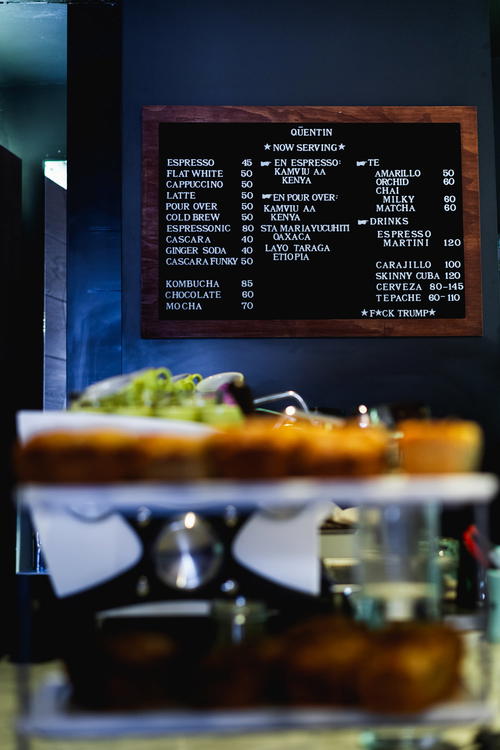
If I’ve never been to a cafe that I’m about to shoot, it’s usually a surprise what I’m going to find inside. I have experience shooting food for restaurants and for those shoots, I would bring a lighting kit in case I didn’t have access to a good natural light source.
Luckily, my A7III does a really good job with low light. Pushing ISO 3200 and 6400 was okay for cafes that were dark inside. For cafes with low-quality overhead lighting, I would pick the best spot that I could find that didn’t have any harsh shadows from those lights.
Within Lightroom, you can spend a lot of time fixing the white balance, desaturating the yellows, split toning and more.


Really, this deserves its own tutorial. My best advice if you’re stuck on editing photos shot in a room with poor lighting is practice.
Don’t avoid a photo shoot if the lighting is bad. Instead, try and make the best of the situation and make the interior look as natural as possible.
It’s super hard to make the interior look like it has good light when it doesn’t. I’ll often play into the mood of poor or odd lighting because it gives more personality to the photo.



How to shoot food outside with harsh light
Shooting anything with harsh light isn’t easy. You are dealing with hard shadows and there’s only so much you can do with pushing the shadows or scaling back the highlights. If you go too far in either direction, the image either looks flat or fake.
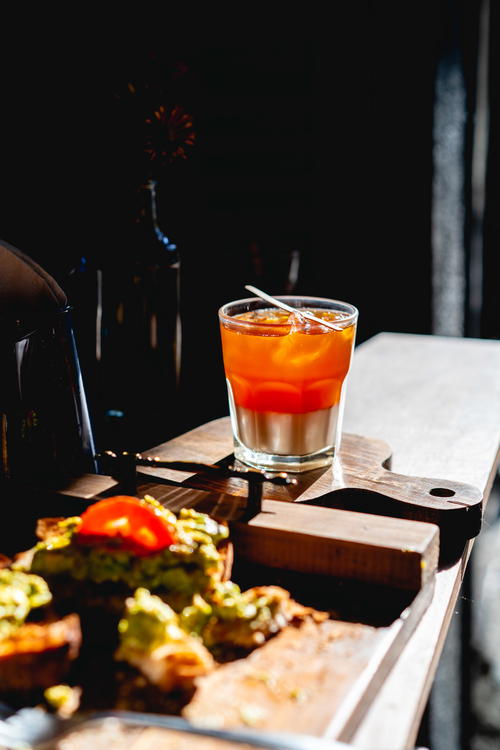
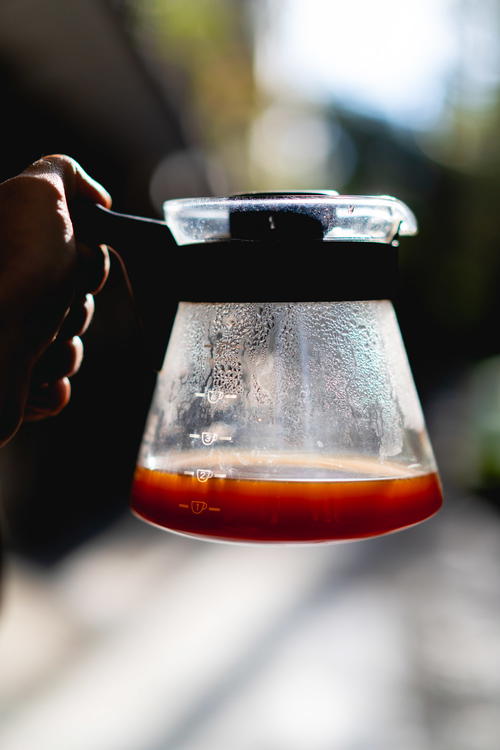
My best advice is to shoot into the sun. In my opinion, food will look flat and lack the color that makes it look appetizing with this angle. When you shoot into the sun, the colors are better, but your chances of blowing out the highlights are high.
I don’t mind this, and sometimes I’ll even increase the highlights to enhance the effect and make the food or drinks glow.


How to make coffee look interesting
I rarely order anything other than black coffee. When Becca and I were writing our Mexico City cafe series, we didn’t want to showcase things that we didn’t like. Because we like black coffee, most of our photos are of black coffee.
On occasion, the cafes served us cold brew (watch out for melting ice cubes!), nitro brew or lattes with art. We made sure to highlight these specialty coffee items in our photos.
When you have cool latte art, that becomes the star of the show. When you have a hot cup of coffee, how can you make that look interesting? I focused a lot on the interior of the cafe and picked other elements from the cafe to use in the background.



If the cafe sold pastries, I would try and include those in the shot to support the story of drinking a cup of coffee. If the cafe had any branding, I would try and focus on their branding to help tell a better story about the cup of coffee.


Use the cafe to tell a story
A good story is the backbone of a good photo. A photo without a story is like a book with no words.
A good trick is to use a human element or add some suspense in the photo. An example of suspense is to purposely exclude a portion of something so that it makes the viewer ask a question.
Multiple photos in a series is another way to tell a story. If you can get a feel for a cafe in three photos, you’ve done a good job. When I would shoot inside the cafes, I wanted to leave with photos that expressed the emotions that I was feeling inside any particular cafe.
Use someone’s hands, coupled with the coffee
One of our favorite ways to show a human element is by having someone (usually Becca) use her hands to hold a mug. This could show that she was using the hot coffee to warm up.
Use a moment of motion
Or, we would capture Becca pouring hot coffee from a glass pitcher or carafe. The pouring in motion shows a dynamic side, and tells the story of something that was only in the moment.
Think outside the box
Other ways to create uniqueness involve going outside the box. One time, I held a wide cup of cold brew up to the light. I looked crazy while I was setting up the photo, but in the end, this photo is unlike any photo I’ve shot before.
Use surroundings to create context
We also use settings to give context. Blend Station in Mexico City is well-known for being a great place to work remotely, so with a focus on a cup of coffee, we have Becca typing on a laptop in the background.
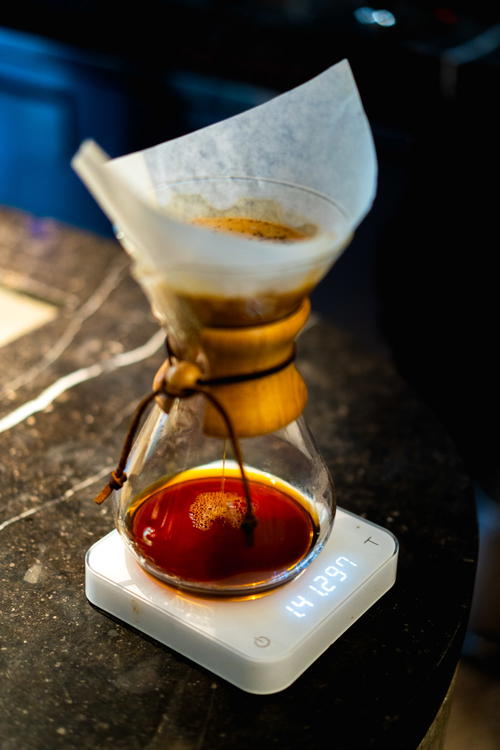


Be mindful of the other cafe customers
If the cafe is open for business, I try really hard not to get in the way of other paying customers. If the light is better by a window, I’ll wait for the window to become open, or I’ll be the first one in the cafe to pick my spot.
After my shoot, I sometimes start to edit the photos in the cafe so that I can show a preview of several cool shots to the owner. If the cafe is super busy, I won’t do this because I don’t want to take up a seat for too long.
Every situation is different, for sure. If you have to ask a customer to move or if you need more space, my best advice is to be respectful and share your intentions. Oftentimes, other customers will be understanding, and they may not have been planning to stay long anyway.
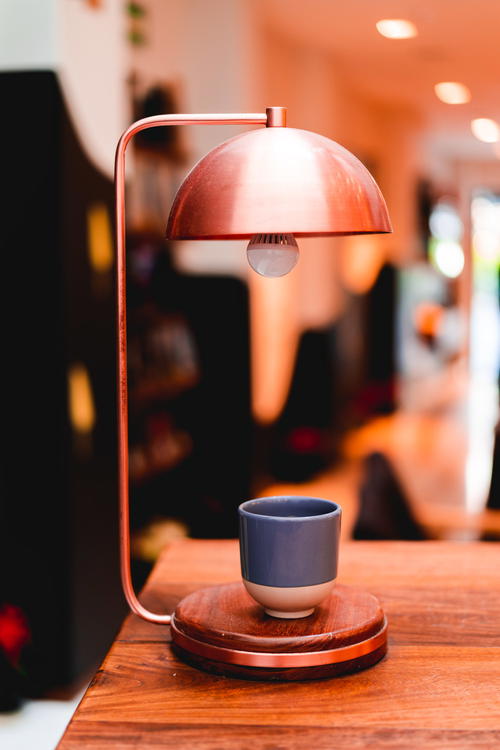


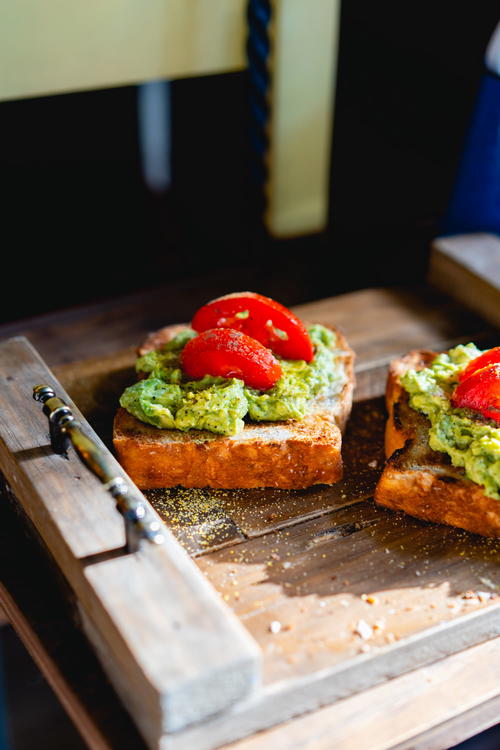
Leverage specialty design elements in cafes
Most cafes will take pride in their decorations and overall ascetic. Use this to your advantage! If a cafe has specific elements that make it unique and special, focus on those elements.
For example, let’s say a cafe has mugs that you wouldn’t see anywhere else. Capture the mugs! Let’s say that a cafe has a lot of plants. Capture the plants, as they can make a space look inviting and green.
Summary of the best tips for taking photos in cafes
If you’ve gotten this far in our guide of tips for photographing coffee and coffee shop environments, your reward is seeing this helpful summary.
In short, a few main tips help set you up for success if you’d like to become expert in taking great photos of coffee in cafes:
- Go early, and contact cafe owners if you’d like some space
- Be creative and memorable with photo composition
- Shoot fast when it comes to hot or cold drinks and foods
- Be ready to deal with low light or harsh light
- Tell a story, and use context for interest
- Be respectful of other customers in the cafe
- Lastly, highlight special features of the coffee shop
We hope you have a great time taking photos the next time you visit a cafe.
How I learned to take photos in cafes
During my month and a half in Mexico City, I took photos in a variety of cafes. This was part of my and Dan’s project to write reviews of various cafes and sit down with the owners to learn their stories.
Our end goal was to publish “Best Cafes of Mexico City” feature for this blog, which has turned into one of our best travel guides.
In visiting a variety of cafes, I learned a lot about shooting coffee and baked goods rather systematically. While this sounds like it may have been repetitive, each cafe presented a set of unique features and challenges.
With some of the technical aspects of food photography, using flashes, reflectors and other equipment is helpful in controlling your environment. When I travel, I don’t bring any of that stuff with me. I’ve been working my kit down to the smallest possible package to travel more “lightly.”
Although it’s ideal to have a nice fill light or some sort of light reflector, you learn a lot by having to take a food or drink photo in a dark room.
Here are a few considerations for your shoot, along with some lessons that I have learned.



📷 Sharpening your photography with us?
We shoot, experiment and share the techniques that work, around the world. If these tips improved your shots, a coffee keeps us creating more photo guidance.
Support more photo tipsYou may also like
-
![A cup of exquisite Mexican coffee and a soothing cup of tea elegantly placed on a wooden table at Blend Station.]()
Review of Blend Station, Mexico City
Among the best laptop-friendly Mexico City cafes is Blend Station, one of the thoughtfully-designed Condesa coffee shops for working and having a great latte.
-
![A bicycle is parked outside of a coffee shop in NYC.]()
A Review of NYC’s Blank Street Coffee Cafes
Blank Street coffee has locations in Manhattan and Brooklyn, and now in the UK, Boston and DC! Is the Blank Street referral program on the app still available for a free coffee?
-
![Hot fresh cup of coffee at Kohvik Komeet in Solaris Mall Sudalinn]()
The Best Cafes for Working in Tallinn, Estonia
We spent a week in Tallinn working remotely and tried as many cafes as we could find. From the Old Town to the downtown areas, here is our list of the best cafes to work from.
-
![A woman is standing at the counter of a coffee shop.]()
Azahar Cafe Review: Authentic Colombian Roast in Bogota
Azahar Cafe in Bogota, Colombia, is regarded as one of the top places to try an authentic Colombian roast in a beautiful cafe.
-
![]()
29 Laptop-Friendly Cafes in Manhattan with WiFi in 2025
Where can you work from home, but in a laptop-friendly cafe in Manhattan? See this list of the best Manhattan coffee shops with WiFi where remote working is welcome.
-
![A woman drinking coffee at a table.]()
Colo Coffee: A Taste of Colombia's Finest Coffee in Bogota
During our trip to Bogota, we discovered the world of Colombian coffee at Colo Coffee. From its expert baristas to its carefully curated beans, see why we consider it the ultimate destination for coffee lovers in the city.





